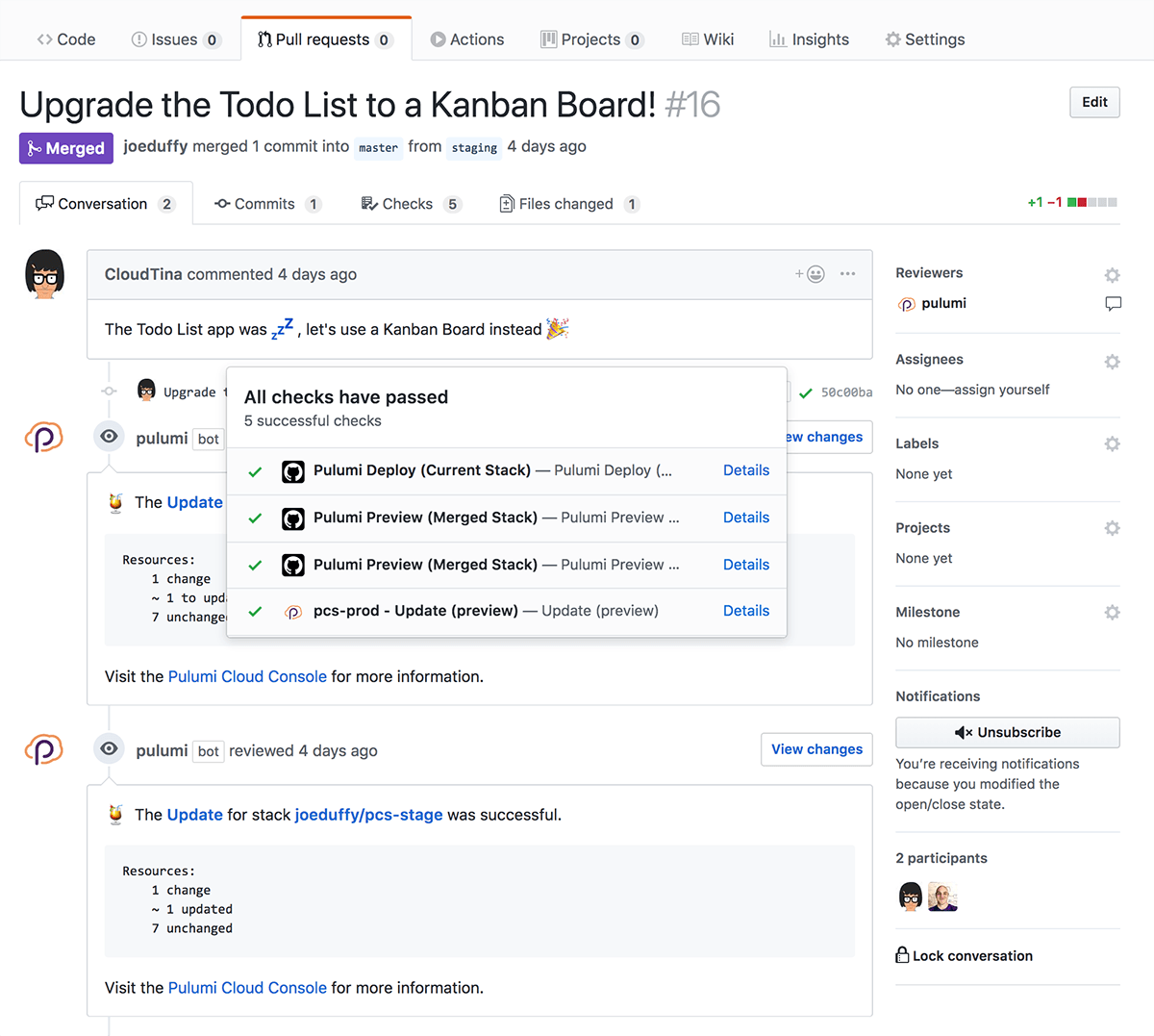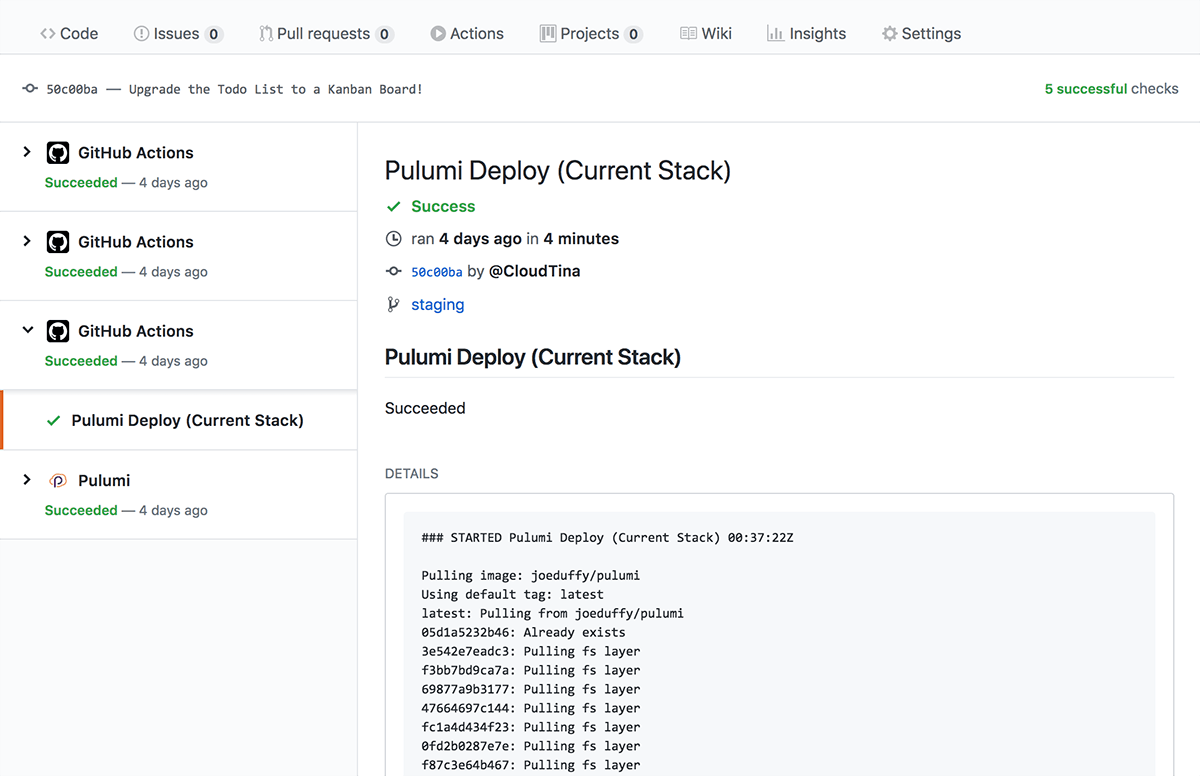Continuous Delivery to Any Cloud using GitHub Actions and Pulumi
Posted on
Today we announced our partnership with GitHub on the new GitHub Actions feature. We are super excited about this bold and innovative technology, especially as it relates to Pulumi, and CI/CD more broadly. We truly believe that Pulumi plus GitHub Actions delivers the easiest, most capable, and friction-free way to achieve continuous delivery of cloud applications and infrastructure, no matter your cloud – AWS, Azure, Google Cloud, Kubernetes, or even on-premises. In this post, we’ll dig deeper to see why, and how to get up and running. It’s refreshingly easy!
GitHub Actions + Pulumi == ❤️
Pulumi lets you write cloud applications and infrastructure in your favorite language. This includes containers, serverless, and even VM-based infrastructure. Combined with GitHub Actions, we can get continuous deployment to any cloud – AWS, Azure, Google Cloud, Kubernetes, or even on-premises – all straight from GitHub.
GitHub Actions gives us a way to run compute in GitHub’s cloud, triggered by any GitHub event – commits, pull requests, and more. This enables us to run Pulumi in response to these events, giving us the benefits of infrastructure as code seamlessly integrated into a lovable workflow. We can edit any files – application- or infrastructure-related – to do end-to-end continuous delivery, without any of the YAML, tedious bash scripting, or manual, error-prone steps.
This capability enables some exciting scenarios:
- Deploy cloud changes anytime a commit is made, including
- Provisioning entirely new cloud environments
- Updating existing infrastructure, like scaling things up or modifying config
- Rebuilding and redeploying app containers to your cluster
- Preview deployments before they’re actually made, integrated with Pull Requests
- Use Git branches to achieve GitOps-style promotion from test/staging to production
To see things in action, check out the video shown at the GitHub Universe keynote today:
In this short video, we see a Ruby on Rails application that is continuously deployed to our Kubernetes cluster (full code available here). It’s just a standard Rails application, with a Dockerfile, and a complete Pulumi infrastructure specification, which are just a collection of TypeScript modules. (We could have used Python or Go.) This includes a fully functioning Google Kubernetes cluster, hosted PostgreSQL database (for easier management!), Kubernetes definitions, and automatic building and publishing of our Rails Docker image to the Docker Hub, which then gets auto-deployed to our cluster. And it works across three entirely separate testing, staging, and production environments!
Notice that it’s all ordinary code, so that it works great with GitHub, in addition to our favorite IDEs and tools.
After committing our changes, Pulumi takes it from there. Deployments can be previewed, diffed, and are recorded so that you’ll always know who changed what, when, and why – all very “Git-like.” Pulumi’s GitHub App adds to this and enables “GitOps” so that teams can propose, approve, and promote code from “staging” to “production” using pull requests (more on that below).
We’ve chosen GKE here as an illustration because it’s amazing how powerful such a simple example can be, but this works just as well if you’re using AKS, EKS, on-premises clusters – and of course works for non-Kubernetes scenarios, like VMs, ECS, and Serverless applications.
All of this with just a handful of TypeScript and GitHub Actions set up to work with Pulumi – despite being quite capable, it’s super easy to get all of this up and running. Let’s see how!
Getting Up and Running
The full sequence of steps is available in our GitHub Actions Getting Started Guide.
In summary, using GitHub Actions with Pulumi is as easy as signing up for Pulumi (if you haven’t already), creating one or more workflow files in your repo (see here for examples), configuring secrets, and adding a Pulumi program. Afterwards, you can simply Commit and Pull Request away to deploy All The Things! GitHub Actions will fire and run Pulumi tasks appropriately; you’ll know it’s working if you see Pulumi actions show up alongside your PRs and commits:

Two sorts of actions, defined the examples referenced above, are
- Pulumi Preview runs
pulumi previewin response to a Pull Request, showing what would happen if the PR were merged into the target branch. - Pulumi Up runs
pulumi upon the target branch, in response to a commit on that branch.
If either of these fail, you’ll see the standard GitHub Checks red “x”, whereas success will give a green “checkmark”; click on either to get the full Pulumi log output:

GitHub Actions’ Logs page, plus Pulumi’s Console, together give you total insight into a deployment’s status, including the Docker build logs, Kubernetes status updates, and more – so you’ll always have the full scoop on what’s going on, good or bad, in your cloud deployments.
Pulumi’s GitHub App
GitHub Actions work with Pulumi without needing any extra configuration beyond the workflow file and GitHub Secrets described above. That’s why it’s so easy!
If you are going to use this setup in a real team setting, you’ll probably also want to use Pulumi’s GitHub App. Simply by installing it into your repo, and combined with the above, you’ll instantly get improved GitHub Checks API integration and, more importantly, context added by the Pulumi bot to your Pull Requests about what a deployment will do before it’s even done, as shown above.
Note that this is optional with GitHub Actions, but worthwhile – it’s much easier for your teams to collaborate on deployments, including knowing whether a change might lead to downtime before it’s even triggered. “GitOps” ahoy!
Learning More
There is so much more fun to have, and we’re just getting started. Look for more in the weeks to come. In the meantime, here are some follow up links in case you want to learn more about GitHub Actions and Pulumi:
- To learn more, install Pulumi and then check out our Getting Started guide.
- In addition to the keynote video, we have two
other videos that you might enjoy watching to learn more:
- In this video, we see the GitOps workflow for promoting from staging to production.
- In this longer-form video, we explore more nuances of how the entire experience works.
- The Ruby on Rails App, deployed to Kubernetes, from the keynote, is available for easy forking here.
This is an exciting day for developers, DevOps engineers, and SREs alike. The combination of GitHub Actions and Pulumi gives us all an easy, automated solution for continuous deployment of cloud applications and infrastructure to any cloud, purely using code and Git. What’s best about it is that it’s fun in the same way programming is fun.
If you’re not yet in the GitHub Actions private beta, but want to try Pulumi, head on over to our Pulumi Getting Started guide. You’ll be running CLI commands, but we think that can be a lot of fun too!
We want to thank our GitHub partners for the bold and innovative work that went into GitHub Actions, and for letting us in on the action – we can’t wait to see what you, the Pulumi community, builds using this magical combination!

